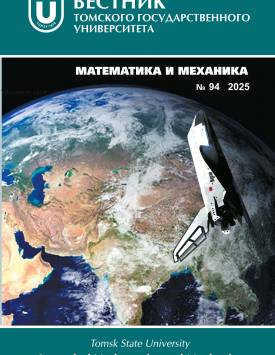Conditions for the reversible deformation of planar bodies weakened by a cut
The body deformation in terms of a planar layer weakened by a cut is considered. As the radius of curvature of the cut tends to zero at the maximum free-energy point, the cut transforms into a mathematical cut. The use of classical conditions for determining the elastic limit leads to the formation of plastic regions under an arbitrarily small external load. To solve this problem, the free energy flow through a cutout arc section is introduced as the product of the free energy density at the point of its maximum and a linear parameter. The free energy flow is represented by the sum of the volumetric- and shape-change energy flows. The energy flow of the shape change is limited by the elastic limit as a result of the accepted generalized condition of reversible deformation. When moving to technological cutouts, converting this condition into the Mises criterion allows one to obtain the threshold length of the linear parameter. For bodies with technological cutouts, the external load corresponding to the elastic limit depends on the curvature radius. For crack-like notches with radii of curvature varying from a threshold value to zero, the external load is constant. Based on the known asymptotic solutions, the external loads corresponding to the elastic limit are obtained using a threshold linear parameter.
Keywords
free energy flow,
ultimate elastic load,
strip with a cutAuthors
| Glagolev Vadim V. | Tula State University | vadim@tsu.tula.ru |
| Kozlov Viktor V. | Tula State University | vvkozlovtsu@mail.ru |
| Markin Aleksey A. | Tula State University | markin-nikram@yandex.ru |
Всего: 3
References
Griffith A.A. The phenomena of rupture and flow in solids // Philosophical Transactions of the Royal Society of London. Series A. 1921. V. 221. P. 163-189. doi: 10.1098/rsta.1921.0006.
Irwin G.R. Plastic zone near a crack and fracture toughness // 7th Sagamore Ordnance Materials Research Conf. 1960. P. IV-63.
Irwin G.R., Kies J.A. Critical energy rate analysis of fracture strength // Welding Journal Research Supplement. 1954. V. 33. P. 193-198.
Irwin G.R. Linear fracture mechanics, fracture transition, and fracture control // Engineering Fracture Mechanics. 1968. V. 1, is. 2. P. 241-257. doi: 10.1016/0013-7944(68)90001-5.
Малик А.В., Лавит И.М. Метод расчета коэффициента интенсивности напряжений для неподвижной трещины нормального разрыва при динамическом нагружении // Вестник Томского государственного университета. Математика и механика. 2018. № 54. C. 88- 102. doi: 10.17223/19988621/54/8.
Murakami Y. A simple procedure for the accurate determination of stress intensity factors by finite element method // Engineering Fracture Mechanics. 1976. V. 8 (4). P. 643-655. doi: 10.1016/0013-7944(76)90038-2.
Rybicki E.F., Kanninen M.F. A finite element calculation of stress intensity factors by a modi fied crack closure integral // Engineering Fracture Mechanics. 1977. V. 9 (4). P. 931-938. doi: 10.1016/0013-7744(77)90013-3.
Caicedo J., Portela A. Direct computation of stress intensity factors in finite element method // European Journal of Computational Mechanics. 2017. V. 26 (3). P. 309-335. doi: 10.1080/ 17797179.2017.1354578.
Seweryn A., Lukaszewicz A. Verification of brittle fracture criteria for elements with V-shaped notches // Engineering Fracture Mechanics. 2002. V. 69 (13). P. 1487-1510. doi: 10. 1016/S0013-7944(01)00138-2.
Dugdale D.S. Yielding of steel sheets containing slits // Journal of the Mechanics and Physics of Solids. 1960. V. 8 (2). P. 100-104. doi: 10.1016/0022-5096(60)90013-2.
Дерюгин Е.Е. Модель трещины с градиентами пластической деформации // Физическая мезомеханика. 2022. Т. 25, № 1. С. 43-65. doi: 10.55652/1683-805X_2022_25_1_43.
Захаров А.П., Шлянников В.Н., Иштыряков И.С. Пластический коэффициент интенсивности напряжений в задачах механики разрушения // Вестник Пермского национального исследовательского политехнического университета. Механика. 2019. № 2. С. 100-115. doi: 10.15593/perm.mech/2019.2.08.
Hilton P.D., Hutchinson J.W. Plastic intensity factors for cracked plates // Engineering Fracture Mechanics. 1971. V. 3. Р. 435-451.
Глаголев В.В., Маркин А.А. Влияние линейного параметра на хрупкое разрушение упругого слоя с круговым отверстием // Прикладная механика и техническая физика. 2023. Т. 64, № 5. С. 159-165. doi: 10.15372/PMTF202315252.
Glagolev V.V., Markin A.A. Fracture models for solid bodies, based on a linear scale parameter // International Journal of Solids and Structures. 2019. V. 158. P. 141-149. doi: 10.1016/j.ijsolstr.2018.09.002.
Глаголев В.В., Маркин А.А. Модель деформирования ДКБ-образца с упругопластическими свойствами // Вестник Пермского национального исследовательского политехнического университета. Механика. 2021. № 2. C. 55-63. doi: 10.15593/perm.mech/2021.2.06.
Berto F., Glagolev V. V., Markin A.A. A body failure model with a notch based on the scalable linear parameter // PNRPU Mechanics Bulletin. 2018. Is. 4. P. 93-97. doi: 10.15593/perm. mech/2018.4.08.
Сукнев С.В. Нелокальные и градиентные критерии разрушения квазихрупких материалов при сжатии // Физическая мезомеханика. 2018. Т. 21, № 4. C. 22-32. doi: 10.24411/1683-805X-2018-14003.
Сукнев С.В. Применение подхода механики конечных трещин для оценки разрушения квазихрупкого материала с круговым отверстием // Известия Российской академии наук. Механика твердого тела. 2021. № 3. С. 13-25. doi: 10.31857/S0572329921020161.
Богачева В.Э., Глаголев В.В., Глаголев Л.В., Маркин А.А. К нахождению предела упругости адгезионного слоя при его нормальном разрыве // Вестник Томского государственного университета. Математика и механика. 2023. № 83. С. 59-73. doi: 10.17223/19988621/83/6.
Creager M. The elastic stress field near the tip of a blunt crack: Master's Thesis. Lehigh University, 1966.
Ильюшин А.А. Пластичность. М. -Л.: ГИТТЛ, 1948. Ч. 1: Упругопластические деформации. 376 c.
Пестриков В.М., Морозов Е.М. Механика разрушения. СПб.: Профессия, 2012. 552 c.

